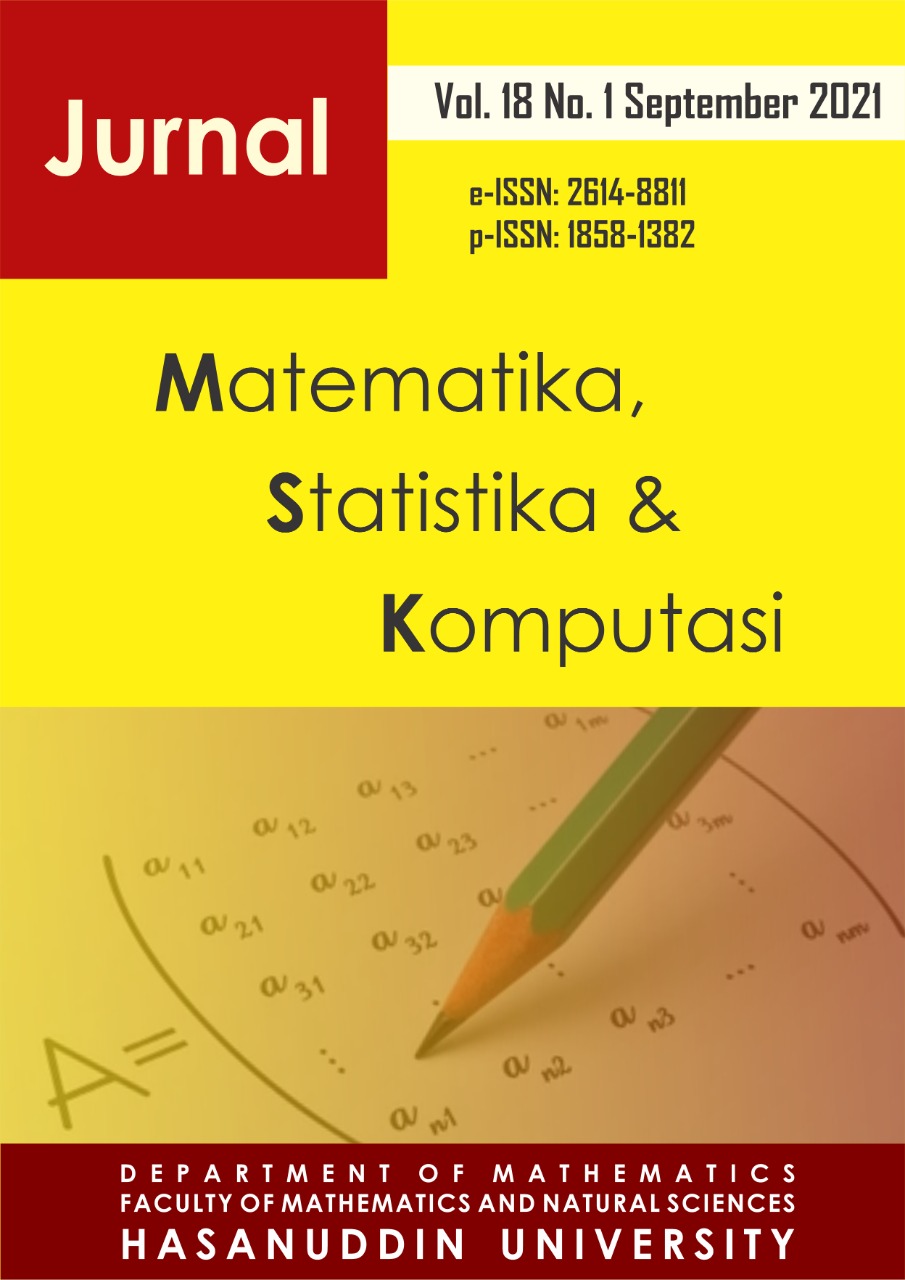Grouping Districts/Cities in Kalimantan Island Based on The People's Welfare Indicators Using Fuzzy C-Means and Subtractive Fuzzy C-Means Methods
DOI:
https://doi.org/10.20956/j.v18i1.14416Keywords:
FCM, People's Welfare Indicators, SFCM, validity indexAbstract
Cluster analysis has the aim of grouping several objects of observation based on the data found in the information to describe the objects and their relationships. The grouping method used in this research is the Fuzzy C-Means (FCM) and Subtractive Fuzzy C-Means (SFCM) methods. The two grouping methods were applied to the people's welfare indicator data in 42 regencies/cities on the island of Kalimantan. The purpose of this study was to obtain the results of grouping districts/cities on the island of Kalimantan based on indicators of people's welfare and to obtain the results of a comparison of the FCM and SFCM methods. Based on the results of the analysis, the FCM and SFCM methods yield the same conclusions, so that in this study the FCM and SFCM methods are both good to use in classifying districts/cities on the island of Kalimantan based on people's welfare indicators and produce an optimal cluster of two clusters, namely the first cluster consisting of 10 Regencies/Cities on the island of Kalimantan, while the second cluster consists of 32 districts/cities on the island of Borneo.Downloads
References
Alwi, W., Hasrul, Muh., 2018. Analisis Klaster untuk Pengelompokan Kabupaten/Kota di Provinsi Sulawesi Selatan Berdasarkan Indikator Kesejahteraan Rakyat. Jurnal MSA, Vol.6, No.1, pp. 35-42.
Azar, A. T, El-Said, S. A., Hassanien, A. E., 2013. Fuzzy and Hard Clustering Analysis for Thyroid Disease. Computer Methods and Programs in Biomedicine, Vol.111, No.1, pp. 1-16.
Bataineh, K. M, Naji, M., Saqer, M., 2011. A Comparison Study Between Various Fuzzy Clustering Algorithms. Jordan Journal of Mechanical and Industrial Engineerin, Vol.5, No.4, pp. 335-343.
Dubey, A. K., Grupta, U., Jain, S., 2018. Comparative Study of K-Means and Fuzzy C-Means Algorithms on The Breast Cancer Data. International Journal on Advanced Science Engineering Information Technology, Vol. 8, No.1, pp. 18-29.
Hossen J., Rahman, A., Sayeed, S., Samsuddin, K., Rokhani, F., 2011. A Modified Hybrid Fuzzy Clustering Algorithm for Data Partitions. Australian Journal of Basic and Applied Sciences, Vol.5, No.8, pp. 674-681.
Jang, J-S. R., Sun, C-T, Mizutani, E., 1997. Neuro-Fuzzy and Soft Computing: A Computational Approach to Learning and Machine Intelligence. New Jersey: Prentice-Hall Inc.
Kusumadewi, S, Purnomo, H, 2010. Aplikasi Logika Fuzzy untuk Pendukung Keputusan Edisi 2. Yogyakarta: Graha Ilmu.
Le, T., Altman, T., 2011. A new initialization method for the Fuzzy C-Means Algorithm using Fuzzy Subtractive Clustering. Proc. International Conference on Information and Knowledge Engineering, Vol.1, pp. 144-150.
Liu, W. Y., Xiao, C. J., Wang, B. W., Shi, Y., Fang, S. F., 2003. Study on Combining Subtractive Clustering with Fuzzy C-Means Clustering. International Conference on Machine Learning and Cybernetics, Vol.5, pp. 2659-2662.
Maseleno., A., Sugiyarti, E., Jasmi, K. A., Basiron, B., Huda, M., Shankar K., 2018. Decision Support System of Scholarship Grantee Selection Using Data Mining. Internasional Journal of Pure and Applied Mathematics, Vol. 119, No. 15, pp. 2239-2249.
Pantula, P. D., Miriyala, S. S., Mitra, K., 2020. An Evolutionary Neuro-Fuzzy C-Means Clustering Technique. Engineering Applications of Artificial Intelligence, Vol. 89, pp. 103435-103450.
Prasetyo, E., 2014. Data Mining Mengolah Data Menjadi Informasi Menggunakan Matlab. Yogyakarta: ANDI.
Santoso, S., 2015. Menguasai Statistik Multivariat. Jakarta: PT Elex Media Komputindo.
Sardar, T. H, Ansari, Z., 2018. An Analysis of Map Reduce Efficiency in Document Clustering Using Parallel K-Means Algorithm. Future Computing and Infoematics Journal, Vol. 3, Issue 2, pp. 200-209.
Wang, W., Zhang, Y., 2007. On Fuzzy Cluster Validity Indices. Fuzzy Sets System, Vol.158, No.19, pp. 2095-2117.
Zhu, X., Pedrycz, W., Li, Z., 2017. Fuzzy Clustering with Nonlinearly Transformed Data. Applied Soft Computing, Vol. 61, pp. 364-376.
Downloads
Published
How to Cite
Issue
Section
License
Copyright (c) 2021 Author and publisher

This work is licensed under a Creative Commons Attribution 4.0 International License.

This work is licensed under a Creative Commons Attribution 4.0 International License.
Jurnal Matematika, Statistika dan Komputasi is an Open Access journal, all articles are distributed under the terms of the Creative Commons Attribution License, allowing third parties to copy and redistribute the material in any medium or format, transform, and build upon the material, provided the original work is properly cited and states its license. This license allows authors and readers to use all articles, data sets, graphics and appendices in data mining applications, search engines, web sites, blogs and other platforms by providing appropriate reference.








